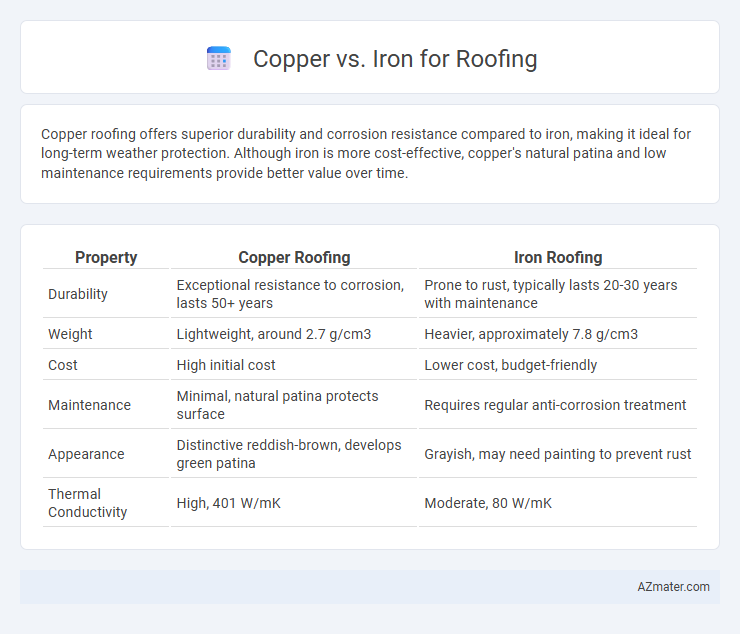Copper roofing offers superior durability and corrosion resistance compared to iron, making it ideal for long-term weather protection. Although iron is more cost-effective, copper's natural patina and low maintenance requirements provide better value over time.
Table of Comparison
| Property | Copper Roofing | Iron Roofing |
|---|---|---|
| Durability | Exceptional resistance to corrosion, lasts 50+ years | Prone to rust, typically lasts 20-30 years with maintenance |
| Weight | Lightweight, around 2.7 g/cm3 | Heavier, approximately 7.8 g/cm3 |
| Cost | High initial cost | Lower cost, budget-friendly |
| Maintenance | Minimal, natural patina protects surface | Requires regular anti-corrosion treatment |
| Appearance | Distinctive reddish-brown, develops green patina | Grayish, may need painting to prevent rust |
| Thermal Conductivity | High, 401 W/mK | Moderate, 80 W/mK |
Introduction to Metal Roofing Materials
Copper and iron are prominent metal roofing materials, valued for their durability and aesthetic appeal. Copper offers exceptional corrosion resistance and a distinctive patina over time, making it ideal for long-lasting, low-maintenance roofs. Iron, particularly galvanized or coated varieties, provides strength and affordability but requires regular maintenance to prevent rust and extend lifespan.
Key Properties of Copper and Iron Roofs
Copper roofs offer superior corrosion resistance, longevity exceeding 100 years, and develop a protective patina that enhances durability and aesthetic appeal. Iron roofs, typically made from galvanized steel or wrought iron, provide high strength and cost-effectiveness but require regular maintenance to prevent rust and corrosion. Both materials have excellent structural integrity, with copper favored for low maintenance and iron preferred for budget-friendly roofing solutions.
Durability: Copper vs Iron
Copper roofing offers exceptional durability with a lifespan of up to 100 years due to its natural corrosion resistance and ability to develop a protective patina over time. Iron roofing, while strong, tends to be more susceptible to rust and corrosion, often requiring regular maintenance and protective coatings to extend its lifespan, typically lasting 20 to 50 years. Copper's superior resistance to moisture, chemicals, and temperature fluctuations makes it a more durable choice for long-term roofing applications compared to iron.
Aesthetic Considerations and Visual Appeal
Copper roofing offers a distinctive aesthetic with its warm, reddish-brown tones that naturally patina to an elegant green over time, creating a timeless and luxurious appearance. Iron roofing, typically featuring darker, matte finishes, provides a more industrial and rustic charm that complements traditional and modern architectural styles. The choice between copper and iron roofing significantly impacts the building's visual appeal, with copper favored for its rich, evolving color and iron preferred for its sturdy, understated look.
Weather Resistance and Longevity
Copper roofing exhibits superior weather resistance due to its natural patina that protects against corrosion, making it highly durable in harsh climates. Iron roofing, although strong, is prone to rust and requires regular maintenance with protective coatings to prevent deterioration. Copper's longevity can exceed 100 years, while iron roofing typically lasts 40 to 50 years with proper care.
Installation Process and Maintenance
Copper roofing offers a lightweight and flexible installation process, often requiring fewer fasteners and allowing for easier shaping around complex roof structures compared to iron. Copper's natural patina forms a protective layer over time, significantly reducing the need for maintenance and resistance to corrosion, whereas iron roofing demands regular inspections, rust treatments, and protective coatings to prevent deterioration. The longevity of copper roofs, often exceeding 50 years with minimal upkeep, contrasts sharply with iron roofs that typically require consistent maintenance to extend their lifespan.
Cost Comparison: Upfront and Long-Term
Copper roofing has a higher upfront cost, typically ranging from $15 to $25 per square foot, while iron roofing usually costs between $8 and $15 per square foot. Long-term, copper roofing offers superior durability, lasting over 50 years with minimal maintenance, which can offset its initial expense through reduced repair and replacement costs. Iron roofing, although more affordable initially, may require more frequent maintenance and replacement every 20 to 30 years, increasing overall lifetime expenditure.
Environmental Impact and Sustainability
Copper roofing offers superior environmental benefits due to its high recyclability and long lifespan, often exceeding 50 years, which reduces resource consumption over time. Iron roofing, while durable, typically has a shorter lifespan and often requires protective coatings that can involve environmentally harmful chemicals. Copper's natural resistance to corrosion minimizes maintenance and replacement frequency, contributing to lower environmental impact compared to iron roofing options.
Common Applications in Modern Architecture
Copper roofing excels in modern architecture due to its durability, corrosion resistance, and unique patina that enhances aesthetic appeal, often used in high-end residential and commercial buildings. Iron roofing, while less common today, finds application in industrial and rustic architectural styles, valued for its strength but requires protective coatings to prevent rust. Both materials offer longevity, but copper is preferred for structures demanding low maintenance and sophisticated design.
Choosing the Right Metal Roof for Your Needs
Copper roofing offers exceptional durability, natural corrosion resistance, and a distinctive aesthetic that develops a unique patina over time, making it ideal for long-term investment and distinctive architectural styles. Iron roofing, often galvanized or coated to prevent rust, provides strong structural support at a lower initial cost and suits industrial or traditional designs requiring robust performance. Evaluating factors like climate, budget, maintenance expectations, and design preferences helps select the metal roof that balances longevity, appearance, and cost-effectiveness.

Infographic: Copper vs Iron for Roofing
 azmater.com
azmater.com